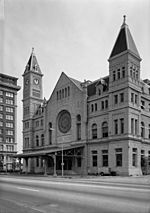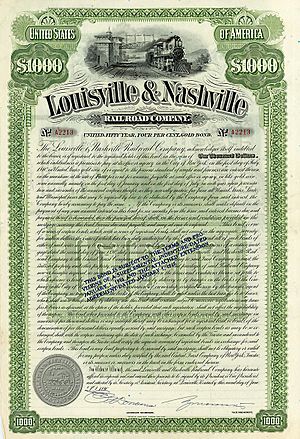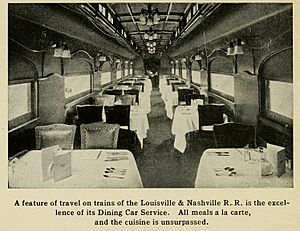Louisville and Nashville Railroad facts for kids
 |
|
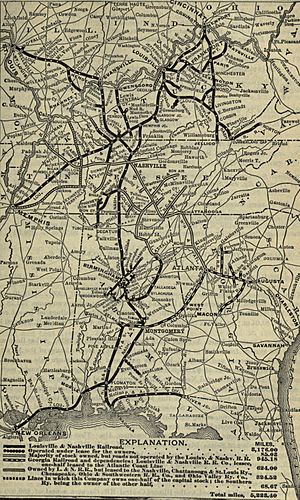
L&N system map, circa 1901
|
|
| Overview | |
|---|---|
| Headquarters | Louisville and Nashville Railroad Office Building, 908 West Broadway, Louisville, Kentucky (1907–1980) Seaboard Coast Line Railroad Building, 500 Water Street, Jacksonville, Florida (1980–1982) |
| Reporting mark | LN |
| Locale | Alabama Florida Georgia Illinois Indiana Kentucky Mississippi Missouri Ohio Tennessee Virginia North Carolina |
| Dates of operation | 1850–1982 |
| Successor | Seaboard Coast Line Railroad |
| Technical | |
| Track gauge | 4 ft 8 1⁄2 in (1,435 mm) standard gauge |
| Previous gauge | 5 ft (1,524 mm), converted by 1870. |
| Length | 10,396 miles (16,731 kilometers) |
The Louisville and Nashville Railroad, often called the L&N, was a major railway company. It moved both goods (freight) and people (passengers) across the southeastern United States. It was known as "The Old Reliable" because it was strong and dependable.
The L&N started in 1850 in Kentucky. It grew into a very successful American business. The company kept the same name for 132 years. It survived big challenges like the American Civil War and the Great Depression. It also adapted to many social and technological changes.
Under its president, Milton H. Smith, the L&N grew a lot. Smith was president for 30 years. The railroad went from less than three hundred miles (480 km) of track to a 6,000-mile (9,700 km) system. It served fourteen different states. The L&N reached far beyond its starting cities of Louisville and Nashville. It connected to places like St. Louis, Memphis, Atlanta, and New Orleans.
The L&N kept growing until the 1980s. During this time, many railroad companies combined. In 1971, the Seaboard Coast Line Railroad bought the L&N. The L&N became a part of it. By 1982, the Seaboard Coast Line fully took over the Louisville & Nashville Railroad. Later, in 1986, the Seaboard System joined with the Chessie System. This new, larger company became CSX Transportation (CSX). CSX now owns and runs most of the old L&N lines.
Contents
Early Days and the Civil War
The L&N's first line went south from Louisville, Kentucky. It took until 1859 to reach Nashville, about 290 km away. By the start of the Civil War, the system had about 250 miles (400 km) of track. Its location was very important. It crossed the lines between the Union and Confederate sides. This made it valuable to both armies.
During the Civil War, both armies used parts of the L&N network. The railroad suffered a lot of damage from battles and sabotage. For example, in July 1863, Union troops used the L&N depot in Lebanon, Kentucky, as a fort. However, the L&N was based in Kentucky, which was a Union state. Also, Nashville fell to Union forces early in the war and stayed under their control.
The L&N made money by moving Union troops and supplies. They were paid in strong Federal money, called greenbacks. Other railroads in the South were badly damaged after the war. The L&N was in a good position to expand. It could hire workers and buy materials cheaply.
Because of these good circumstances, the L&N started to grow. It kept expanding for many years. Within 30 years, its network reached from Ohio and Missouri to Louisiana and Florida. By 1884, the L&N was so important that it was added to the Dow Jones Transportation Average. This was one of the first major lists of important American companies. The L&N was also a big customer of Rogers Locomotive and Machine Works. This company made locomotives. In 1879, they even gave the L&N a free locomotive as a thank-you gift!
Coal and Big Business in the Gilded Age
Back then, all locomotives ran on steam. Many railroads used coal to power their engines. The L&N made sure it had its own coal. It also created a steady income by building lines into coal-rich areas. This included eastern Kentucky and northern Alabama.
In Alabama, the town of Birmingham was new. It had lots of coal, iron ore, and limestone. These are key ingredients for making steel. The L&N brought transport and money to Birmingham. This helped the town grow into a big industrial city. It became the South's first successful city after the Civil War. The L&N's access to good coal was so important. For a few years starting in 1940, it had the nation's longest train run without needing to refuel. This was about 490 miles (790 km) from Louisville to Montgomery, Alabama.
The late 1800s were called the Gilded Age. There were few rules about fair competition or business. Companies often competed very fiercely. The L&N was a tough competitor. It would sometimes block smaller companies from using important places like city train stations. If it couldn't block them, it would use its money to take control. For example, in 1880, it bought most of its main competitor, the Nashville, Chattanooga and St. Louis Railway.
People were upset about this. So, the L&N decided to keep the NC&StL as a separate company. But now, the NC&StL worked *with* the L&N, not against it. Later, in 1902, a rich banker named J. P. Morgan caused the L&N to be controlled by its rival, the Atlantic Coast Line Railroad. But the Atlantic Coast Line didn't try to control how the L&N operated. So, for many years, nothing really changed for the L&N.
The 20th Century and Beyond
The two World Wars put a lot of pressure on the L&N. Its large and strong network handled the demands of war transport well. The profits from these wars were similar to the boost it got from the Civil War. After the wars, the L&N slowly switched to diesel engines. These new, sleek engines pulled some of the most beautiful passenger trains. These included the Dixie Flyer, the Humming Bird, and the Pan-American.

Even after its 100th birthday, the L&N was still growing. In 1957, the Nashville, Chattanooga & St. Louis railway fully joined the L&N. In the 1960s, the L&N bought lines in Illinois. This finally gave it access to Chicago, a very important railway hub. Some parts of the old rival, the Tennessee Central, were also sold to the L&N.
By 1971, the Seaboard Coast Line Railroad bought all the L&N shares it didn't already own. The L&N became a part of that company. Like other railroads, the L&N had already cut back on passenger service. Fewer people were riding trains. In 1971, Amtrak, a new government-formed passenger railway service, took over the few remaining L&N passenger trains. In 1979, the last L&N passenger service ended. Amtrak stopped The Floridian, which ran from Louisville to Nashville and on to Florida.
By 1982, many railroad companies were combining. The Seaboard Coast Line fully absorbed the Louisville & Nashville Railroad. The combined company was called "SCL/L&N" or "Family Lines." This name was even painted on their train cars. Over the next few years, more companies joined, creating the Seaboard System Railroad. Even more changes happened. In 1986, the Seaboard System merged with the Chessie System. This new, combined company became CSX Transportation (CSX). CSX now owns and runs all the former Louisville and Nashville lines, except for some that were closed or sold.
Famous Passenger Trains
The Humming Bird and Pan-American were two of the L&N's most popular passenger trains. They ran entirely on L&N lines, from Cincinnati to New Orleans and Memphis. The Humming Bird later added a section from Chicago to New Orleans.
The L&N also ran other well-known trains, including:
- Azalean (Cincinnati – New Orleans)
- Pre-Amtrak Crescent (New York – New Orleans)
- Dixie Flagler (Chicago – Miami)
- Dixie Flyer and Dixie Limited (Chicago and St. Louis to Jacksonville)
- Dixieland (Chicago – Miami)
- Dixiana (Chicago – Miami)
- Flamingo (Cincinnati – Jacksonville)
- Florida Arrow (seasonal train, Chicago - Louisville -Birmingham - Miami)
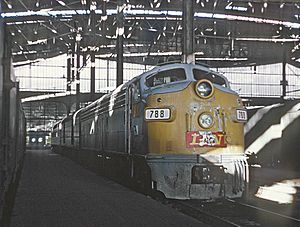
- Georgian (Originally St. Louis – Atlanta, later Chicago-Atlanta)
- Gulf Wind (New Orleans – Jacksonville)
- Piedmont Limited (New York – New Orleans)
- Southland (Chicago – St. Petersburg, Tampa and Miami)
- South Wind (Chicago – Miami)
The L&N was one of the few railroads to stop a passenger train while it was still running. On January 9, 1969, a judge allowed the L&N to stop its southbound Humming Bird. This happened in Birmingham, in the middle of its trip from Cincinnati to New Orleans. The 14 passengers who wanted to continue south had to finish their journey by bus.
L&N's Lasting Impact
Many groups and publications are dedicated to the L&N railroad. Its equipment is also popular in the model railroading hobby. The L&N is mentioned in songs by famous artists like Jimmie Rodgers and Johnny Cash. The song "The L&N Don't Stop Here Anymore" by Jean Ritchie is also about the railroad.
In 1926, the L&N gave about 137 acres of land to Kentucky. This helped create the Natural Bridge State Park.
Preserving L&N History
Several groups work to save L&N equipment and old L&N lines. These include the Kentucky Railway Museum, The Historic Railpark and Train Museum in Bowling Green, Kentucky, and the L&N Historic Society.
The city of Atlanta is home to two famous locomotives: the General and the Texas. These engines were built for the Western and Atlantic Railroad, which was later leased to the L&N's predecessor. The General and the Texas became famous during The Great Locomotive Chase in the Civil War.
The General was displayed in Chattanooga in 1901. In 1957, the L&N restored it to working order. The engine traveled around the eastern U.S. for the Civil War Centennial. It even visited the 1964 New York World's Fair. After a legal fight, the General was given to the state of Georgia in 1971. It is now at the Southern Museum of Civil War and Locomotive History in Kennesaw, Georgia. The Texas is being restored in North Carolina and will return to Georgia later.
The Kentucky Railway Museum has many pieces of L&N equipment. This includes a steam locomotive, No. 152, and several passenger cars. Many of these need restoration.
The Historic Railpark and Train Museum also owns L&N equipment. This includes a diesel locomotive, a Railway Post Office car, a dining car, and a sleeping car.
Other museums, like the Bluegrass Railroad Museum, also have L&N equipment. L&N steam locomotive 2132 is on display in Corbin, Kentucky. It was moved from Georgia and fully restored to look like new. An L&N caboose, 1056, is also there.
The Wilderness Road Trail is a walking and biking path. It was built on an old L&N railway path from Cumberland Gap National Historical Park to Ewing, Virginia.
Images for kids


